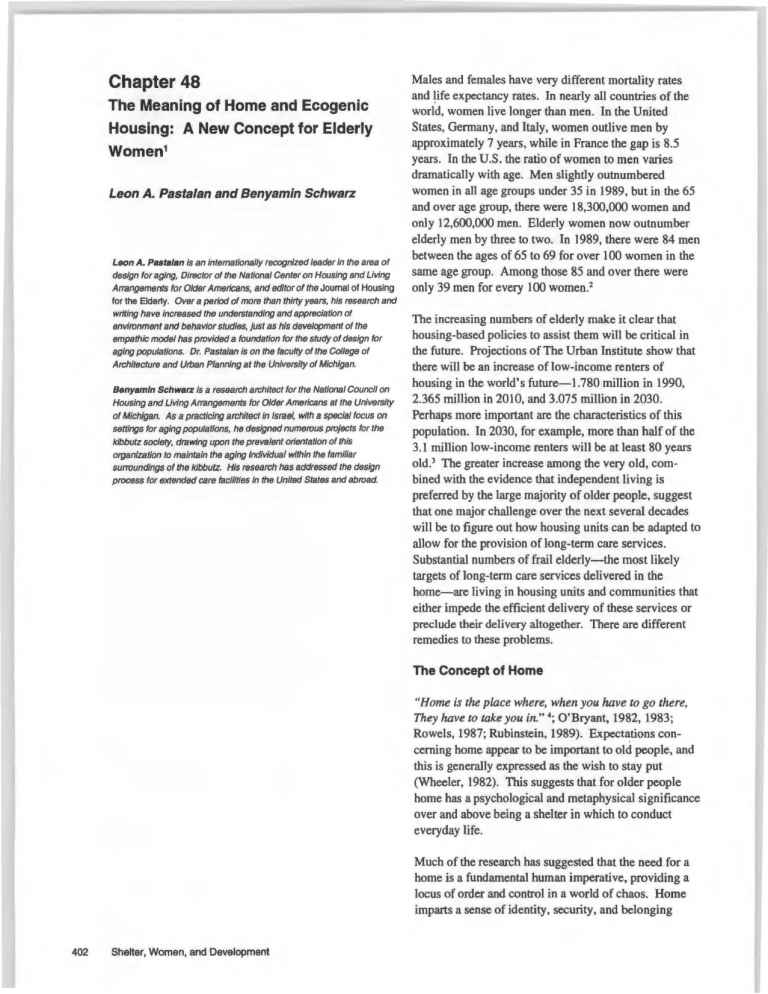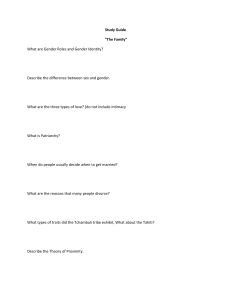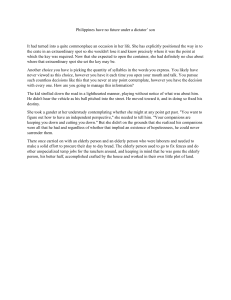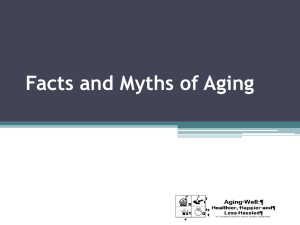
Chapter 48 The Meaning of Home and Ecogenic Housing: A New Concept for Elderly Women1 Leon A. Pasta/an and Benyamln Schwarz Leon A. Paste/en Is an internationally recognized leader In the area of design for aging. Director of the National Center on Housing and Lillfng Arrangements for Older Americans, and editor of the Journal of Housing lor the Elderly. Over a period of more than thirty years, his research and writing have increased the understanding and appreciation of environment and behavior studies, just as his development of the empathic modal has provided a foundation for the study ofdesign for aging populations. Dr. Pasta/an Is on the faculty of the College of Architecture and Url>an Planning at the University of Mich/gen. Benyemln Schwtlrz Is a research architect for the National Council on Housing and Lillfng Arrangements for Older Americans at the University of Michigan. As a practicing architect In Israel, with a special focus on settings for aging populations, he designed numerous projects for the kibbutz society, drawing upon the prevalent orientation of this organization to maintain the aging Individual within the familiar surroundings of the kibbutz. His research has addressed the design process for extended care facilities in the United States and abroad. Males and females have very different mortality rates and !ife expectancy rates. In nearly all countries of the world, women live longer than men. In the United States, Germany, and Italy, women outlive men by approximately 7 years, while in France the gap is 8.5 years. In the U.S. the ratio of women to men varies dramatically with age. Men slightly outnumbered women in all age groups under 35 in 1989, but in the 65 and over age group, there were 18,300,000 women and only 12,600,000 men. Elderly women now outnumber elderly men by three to two. In 1989, there were 84 men between the ages of 65 to 69 for over 100 women in the same age group. Among those 85 and over there were only 39 men for every 100 women.2 The increasing numbers of elderly make it clear that housing-based policies to assist them will be critical in the future. Projections of The Urban Institute show that there will be an increase of low-income renters of housing in the world's future-1.780 million in 1990, 2.365 million in 2010, and 3.075 million in 2030. Perhaps more important are the characteristics of this population. In 2030, for example, more than half of the 3.1 million low-income renters will be at least 80 years old. 3 The greater increase among the very old, com­ bined with the evidence that independent living is preferred by the large majority of older people, suggest that one major challenge over the next several decades will be to figure out how housing units can be adapted to allow for the provision of long-term care services. Substantial numbers of frail elderly-the most likely targets of long-term care services delivered in the home-are living in housing units and communities that either impede the efficient delivery of these services or preclude their delivery altogether. There are different remedies to these problems. The Concept of Home "Home is the place where, when you have to go there, They have to take you in." 4 ; O'Bryant, 1982, 1983; Rowels, 1987; Rubinstein, 1989). Expectations con­ cerning home appear to be important to old people, and this is generally expressed as the wish to stay put (Wheeler, 1982). This suggests that for older people home has a psychological and metaphysical significance over and above being a shelter in which to conduct everyday life. Much of the research has suggested that the need for a home is a fundamental human imperative, providing a locus of order and control in a world of chaos. Home imparts a sense of identity, security, and belonging 402 Shelter, Women, and Development (Rowels, 1987). It is space differentiated from a world outside that is often viewed as hostile. Crossing the threshold to depart involves a transition from the sacred to the profane (Eliade, 1961). Home is a place of protection, a refuge. To be at home is to know where you are; it means to inhabit a secure center and to be oriented in space. Home as territory can include a room inside a house, a house within a neighborhood, a neighborhood within a city, and a city within a country. At each level the meaning of home gains in intensity and depth from the interaction between the experience of the place and its context at a large scale. This larger home alludes to hierarchy of places within which we are oriented, and distinguished from the larger and stranger surroundings. Home in the sense of territory is a place where one can be independent, be in charge and take control, even if it is perceived control, which means the extent to which we believe that what happens to us is a matter of fate, luck, or our own powerlessness, versus a belief that we are the masters of our own destinies and usually determine our own actions (Howell, 1985). Within the privacy of home, an older person can control, and often conceal, declining capacities in the manage­ ment of daily living. The familiarity of the setting permits what Rowels (1983) called a sense of "physical insideness" where familiarity, at a less than conscious level, can compensate for the progressive sensory loss likely to accompany age. The ability to continue to master the physical environment despite frailty confers power upon the individual, and in tum can enhance personal capacity to interact beyond the locus of home (Willcocks, Peace and Kellaher, 1987). Home is a kind of origin; we go "back" home even when our arrival is in the future. We inhabit our home day after day until we develop a sense of familiarity with the environment to the degree that it becomes predictable and taken for granted (Dovey, 1985). Home has strong roots in the experiences of childhood. Claire Cooper Marcus (1978) suggested that there are connections between the visual images of childhood home and the environmental attitudes towards homes expressed in adult life. Feuerstein (1965) referred to the materials and the forms of home which reflect our knowledge of how the places in which we dwell came into being. This provides us with a sense of home even when we were not engaged in the construction. There are infinite variations in the forms of dwellings. Cultural beliefs and social practice represent the ordering systems that select choices from among these possibilities and shape the broad range of formal manifestations of home within any sociocultural context (Benedict, 1946). Spatial arrangements and environ­ mental settings support patterns of experience and behavior. Patterns of activities like dining, talking, bathing, sleeping, studying, and watching television form much of the programs in housing design. These are patterns that orient us in space, in time, and in sociocultural context. They are not embodied in a house or certain building but in our experience and behavior, and as such they can be transposed from place to place. In this sense the meanings of home may be revoked if the patterns are recreated. Although the particular spatial patterns may be sociocultural, the sense of connectedness may be more personal (Dovey, 1985). For example, lovers can transcend a dependence on place; a small motel room can be perceived by them as home. Their love can elevate any place they happen to be into a home. This is not to say that the physical environment makes no difference. However, the sense of home may be developed in any setting for activities if people elevate the place into home space by attributing to it certain characteristics and allowing homelike activities to take place. Home is a place where our identity is continually evoked through connections with the past. Our experience in the world carries its own meanings, and the places in which these experiences occur become ingrained with those meanings. The physical environment plays a very important role because it enables us to materialize our memory through association with places. The memories reflected in the home environment help to create our experiences of home, and those experiences serve in tum to preserve, evoke, and even revise the memory. This theme of connection is fundamental within the concep­ tion of home as a focus of self-identity. Home environ­ ment may be repository of memories and provide a link with the past, either through meanings accumulated from the recollection of events that took place within the physical setting or through the memories and sense of self that are evoked through personal possessions and artifacts maintained within the home (Rowels, 1987). Boschetti (1984) expressed this: Our past belongs to us. And personal possessions are tangible parts of that past. The silver, crystal, fine china, linens, odd pieces of furniture-mostly wood because it withstands the rigors of time-scrapbooks, photo albums, family portraits, and other random memorabilia of a person's life on earth, which get passed on, are the tangible Shelter, Women, and Development 403 parts of a person's life. During life these items by their daily presence serve to remind the person who she or he is; when handed down they carry with them the giver's tangible presence into the future. 5 Dovey ( 1985) summarized the concept of home as a schema of relationships that bring order, integrity, and meaning to experience in place-a series of connections between person and world: Connectedness with people Connectedness with the place Connectedness with the past, and Connectedness with the future We may distinguish between: 1. Home as a safe place. A shelter from the elements and from other threats. A familiar and predictable place, where we can perform in safety and security. 2. Home as a place where we expect to have support and help, love and happiness. A place where one can live and not only stay. A place where people love us and care for us. An image of a family that evokes connotations such as affection, support, loyalty, obligations, and responsibilities. 3. Home as a place where we choose our own life style and perform desired activities not as patients, but as residents. 4. Home as a territory that we control. A place which symbolizes our permanent right to be there. In this territory we can make the rules and the regulations. We can personalize the place, control the architectural appearance and the furniture arrangement, control the lighting and the temperature, and we can control our and others' behavior. 5. Home as a place for personal identity. A place that we can personalize with our artifacts which express us. A place that we can design based on our preference to express our values in such a way that the place expresses us and we identify with it. 6. Home as a place that protects our privacy. A place where we have the needs, the rights, and the opportunities for the highest level of privacy. Home is a place where we can shut the door on some stranger who wants to intrude on our privacy. Home enables us to take off our "costumes" and "masks" and be ourselves, to take a rest from society' s demands, to relax, and to accumulate energy for our next "performance." 7. Home as a place of continuity. A place that symbolizes our personal and family's history, and maintains the connections to our past. Home as a repository of memories and a provider of links with the past. 8. Home as an expression of a social status. Ownership as symbol of status, success, and achievement. Location, 404 Shelter, Women, and Development architectural appearance, and interior design all contribute to this .meaning. 9. Home as place where we prefer to die. All these attributes represent the phenomenon of home which is an intangible relationship between people and the places that they dwell. Several publications of environment geared toward elderly intend to derive the images of home through the intangible qualities of artifacts and environmental components such as soft hues or bright airiness. Other properties are more tangible and refer to qualities of home as a contrast to the institutional environment. Properties like central living rooms, carpeting, comfortable chairs, scale of rooms, arrangements of furniture, windows, ventilation, noise reduction devices, lighting, short corridors, etc., have significance. They all evoke collective memories of the warm, small-scale, cozy, comfortable environ­ ment of an ideal home setting. They illustrate the promise of a home experience carefully packaged in the homelike concept for the residents and their families. Promises assumed in the homelike image are an effort to create the complete opposite of the institutional image. In this view, the institution has over-worked, under-paid staff intent on performing instrumental tasks for pay; in homelike environment we have caregivers caring for beloved residents, almost like children in a family caring for beloved parents at home. In an institution the resident is a "case"; in a homelike setting the old person remains a parent, grandparent, and friend. The institu­ tional facility allows little personal autonomy; in the homelike environment individuals are responsible for setting their own schedule and control of their surround­ ings. Residents of an institution are isolated from the community; members of a homelike facility are involved in the community. Institutional food can be disgusting; home-cooked food, nourishing. The institutional environment is barren and cold; the homelike setting is cheerful and warm. Within an institution elderly sit apathetically waiting for visitors and social interaction; in a homelike environment people socialize with each other. Indeed, we have constructed a continuum, with the institution at one end and the home at the other (Figure 1). The Concept of Ecogenic Housing Ecogenic Housing is a concept developed to balance the issues of security and autonomy in a home environment. Institution ~ Increasing Level of Homelike 1) Safety and Security 2) Help in ADLs 3) Social Distance from Caregivers 4) Block Treatment 5) Limited Territory and Control 6) Lack of Variation, Routine 7) Depersonalization 8) No 'Wonted Supports' 9) Sameness of Care 10) Nobody Wants to Die There -----~~ A. Home 1) 2) 3) 4) Safety and Security Love, Support, Help, Happiness Family, Loyalty, Obligations Choice of Lifestyle 5) Territory to Protect and Control 6) 'Personal Identity 7) Protection of Privacy 8) Continuity, Connections to Past 9) Expression of Social Status 10) Preferred Place of Death Fig. 1: The Home-Institution Continuum. The purpose of Ecogenic Housing is to provide opportu­ nities for companionship and socialization; safety and protection from crime; enhanced productivity in cooperative efforts regarding activities of daily living; privacy and autonomy; and provision of home health services, all within a family lifestyle at an affordable cost. Ecogenic Housing for the elderly can be characterized in most instances as a situation in which at least two economically unrelated persons share selected common areas including kitchen and living and dining areas, but have their own private sleeping, social, and sanitation areas. While each individual shares some common areas, each is viewed as independent and constituting a separate household. Social isolation is very common among the elderly, especially those persons of advanced years who are widowed or unattached. Elderly people living alone comprise close to one-third of all older people. In 1989, 8,900,000 Americans 65 and over lived alone. The economic status of elderly people who live alone is markedly lower than that of those who live with others. For example, 24% of elderly people living alone are poor, compared with 14% of those who live with others. Companionship and socialization within a family lifestyle can lead to improvement in mental and physical health because activities of daily living (ADL) can be enjoyed and shared by others. Meals, for instance, would be more enjoyable since one is no longer eating alone and hence better nutrition would positively affect one's level of well-being. The kitchen provides activi­ ties for meal preparation and consumption, but does not mandate such activity. The person is free to take meals elsewhere or have meals delivered. Fear of crime and anxiety regarding safety and security are high among the concerns the elderly express. While perceived threats of crime frequently exceed actual incidences, real as well as perceived security and personal safety are clearly enhanced with numbers as opposed to living alone. Activities of daily living such as household chores are cooperatively shared and make such tasks easier to deal with. Meal preparation and other household chores demand a continuous involvement and investment of oneself. These demands help to keep the residents active, contrasted with the passivity of persons where such services are provided by others. Cooperative efforts have an important impact on the older person's productivity. Productivity here is viewed broadly and includes anything which produces goods and services. These need not be marketable so long as they reduce the demands on goods and services produced by others. Thus, cooperative efforts with such activities of daily living would be considered productive if the person or persons might otherwise have required someone to provide that care or activity. This, however, does not alter the fact that community agencies and service Shelter, Women, and Development 405 .. ..."r•., ·..,,"'·· .,,,,t,, ....... . ,,, .....'It•... Fig. 2: Ecogenic House. A Aoor Plan. providers could offer various services pertaining to activities of daily living if needed. Privacy of each individual is assured by the provision of an area for private activity such as sleeping, sanitation, and social as well as other activities of a personal nature. Depending on need and circumstances, the physical arrangement of the unit allows each individual to engage in activities with others or disengage for private activi­ ties. The Ecogenic Housing arrangement can also provide a context for the delivery of home health services in a non-institutionalized, family setting. With a consciously designed supportive environment including flexible physical spaces, products which assist in activities of daily living, as well as appropriately trained service delivery personnel and cooperation from fellow resi­ dents, members of such a housing arrangement would require shorter stays in hospitals to recover from an acute illness or, in case of chronic health problems, to avoid premature and costly nursing home care 406 Shelter, Women, and Development Affordability is enhanced due to savings in construction costs of the shared spaces such as the kitchen and dining and living areas; and reduced administrative and service costs. In sum, Ecogenic Housing provides decent shelter with many physical, psych<Vsocial, and health care amenities in a non-institutionalized family setting at a price moderate- and low-income elderly persons can afford. Appearance and Function The physical appearance of this purpose-built residential unit is that of a four bedroom house with a maximum of four persons (Figure 2). The style could be made to fit any neighborhood, e.g., from a colonial to a ranch or anything in between. This provides the potential for locating such housing on one lot in a neighborhood or, if it seems called for, a whole subdivision. The important point here is that it is kept in residential context and in a family lifestyle and avoids the negative aspects of an institution. This approach can serve a whole range of housing needs. For instance, it can respond to the high cost of housing and could serve elderly persons who are physically independent and healthy but have an affordability problem. It could also serve as a non­ institutional, family-scale response to congregate housing for the elderly or for assisted living for younger, physically handicapped persons. This would be made possible through the appropriate orchestration of the design of physical spaces and products which assist in activities of daily living and service delivery personnel. The economic viability of such housing has been demonstrated through a financial analysis and can be viewed as a sound investment. However, perhaps more importantly, an appropriate business organization has an opportunity not only to develop and build such housing but to test and develop a range of supportive products as well. Research and development in the area of home health care represents a unique opportunity. With the pressure to discharge patients from acute care hospitals in ever shorter periods of time and the prohibitive cost of nursing home care, it is obvious that health care in the home is the wave of the future. The testing and devel­ oping of appropriate assistive devices, changing configurations of various residential spaces, more supportive furniture and appliances, etc., in a residential setting are only a few of the necessary things that need to be done. This housing concept promises to meet emerging housing and health care·needs of our society through the design and construction of such housing as well as its supportive product environment. References AARP. Aging America (Trends/Projections), 1991. Feuerstein, G. "Unpremeditaled architecture." Lmulscape, 13 (3), 33­ 37,1965. Howell, S. "Home: A Source of Meaning in Elders' Lives." Generations,JX(3): 5~. 1985. Marcus, Claire Cooper "Remembrance of landscapes past." Lmulscape, 22 (3), 34-43, 1978. O'Bryant, S. L. "The value of home to older persons and its relationship to housing satisfaction." Research on Aging, 4, 349-363, 1982. O'Bryant, S. L. "The subjective value of "home" to older homeowners." Journal ofHousing for the Elderly,], 29­ 43, 1983. Rowels, G. D. "Place and personal identity in old age: Observations from Appalachia." Journal ofEnvironmental Psychology, 3, 299-313, 1983. Rowels, G. D. "A Place to Call Home." In: Handbook ofClinical Gerontology. Ed. L. L. Carstensen and B. A. Edelstein. pp. 335-353. New York: Pergamon Press, 1987. Rubinstein, R. L. ''The Home Environments of Older People: A Description of the Psychosocial Processes Linking Person to Place." Journal ofGerontology: Social Sciences, 44 (2), 545-553, 1989. Seamon, D. "Newcomers, existential outsiders and insiders: Their portrayal in two books by Doris Lessing." In Humani!tic geography and literature. Ed. D.C. D. Pocock. London: Croon Helm, 1981. Wheeler, R. "Housing and the Elderly." In Aging and Social Policy, C. Philipson and A. Walker (Eds.). Aldershot, Hants: Gower Publishing Co, 1982. Willcocks, D., Peace, S., and Kellaher, L. Private Lives in Public Places. New York: Tavistock Publications, 1987. Zedlewski, S. R., Barnes, R. 0., Burt, M. R., McBride, T. D., and Meyer, J. A. The Needs ofthe Elderly in the 21st Century. Urban Institute Report 90-5. Washington, D.C.: Urban Institute Press, 1990. Altman, I. and Werner, C. (Eds.) Home Environments. New York: Plenum Pn:ss, 1985. Benedict, R. Patterns ofculture. New York: Mentor, 1946. 1 AARP' s Aging America (Trends/Projections) 1991. Boschetti, M. A. The older person's emotional attachment to the physical environment ofthe residential setting. Unpublished doctoral dissertation. Ann Arbor: The University of Michigan, 1984. 2 Ibid. Dovey, K. "Home and Home1essness." In: Home Environments. Eds. I. Altman and C. Werner. New York: Plenum Press, 1985. • Robert Frost. The Death ofthe Hired Man. Eliade, M. The sacred and the profane. New York: Harper & Row, 1961. ' Zedlewsld, S.R., et. al. The Needs ofthe Elderly in the 21st Century, 1990. ' Boschetti, M.A. (1984). The older person's emotional attachment to the physical environment of the residential setting, p. 39. 6 AARP's Aging America (Trends/Projections) 1991. Shelter, Women, and Development 407





